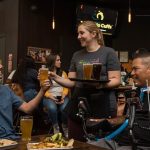In the hustle and bustle of our everyday lives, the kitchen often becomes a hub of activity. It’s not just a place to cook, but a space where we gather, socialize, and eat. The importance of a well-designed kitchen is undeniable, but have you ever thought about how lighting can affect your cooking and eating environment?
The Role of Lighting in Kitchen Design
The lighting in your kitchen can make a significant difference in your cooking experience. The right lighting will not only improve the quality of your meals but also your overall health. Just as important as the design of your kitchen, lighting plays a crucial role in the functionality, comfort, and overall atmosphere of your cooking space.
In the same genre : What are the benefits of having a soup maker in your slimming kitchen?
The right lighting can enhance the colors and textures of food, making it more appealing. More than that, with the right illumination, you can accurately determine the freshness of ingredients, ensuring the quality of what you’re eating. It can also help you perform cooking tasks with ease and precision, reducing the risk of accidents and mishaps.
But beyond its practical role, lighting can also set the mood in your kitchen. A well-lit kitchen encourages a calm and focused environment, making the act of cooking more enjoyable and less stressful. This can lead to healthier eating habits as a relaxed cook is more likely to take time in preparing nutritious meals.
Have you seen this : How do you organize a pantry to support a low-carb diet?
The Impact of Lighting on Health and Eating Habits
Health is a high priority for many of us, and the kitchen environment plays a significant role in our eating habits. A well-lit kitchen not only aids in cooking but also promotes mindful eating. Light can influence our perception of taste and even our appetite.
Bright, cool light can make food look more appetizing, encouraging us to eat more. On the other hand, warm, dim light may make us eat slower and less. This is why many restaurants use warm, ambient lighting. It creates a comfortable, relaxed atmosphere that encourages customers to stay longer and eat more.
In a school setting, studies have shown that students are more likely to choose healthier food options in a brightly lit cafeteria. If bright light can encourage healthier eating in schools, why not apply the same concept in our kitchens?
Choosing the Right Kitchen Lighting
So, what type of lighting is best for a calm and dietary-focused kitchen? The answer is a combination of different lighting types.
For tasks such as chopping and cooking, you will need high-quality task lights. These should be cool white to daylight in color, providing the best illumination for these detailed tasks. This light source should be placed where it doesn’t cast shadows.
Ambient or general lighting is also essential. This serves as the main source of light in your kitchen. It should provide uniform light distribution, creating a comfortable and welcoming environment. A mix of overhead lights and floor level lighting can achieve this.
Accent lighting is used to highlight specific areas or objects in your kitchen. You could use it to draw attention to a beautifully tiled backsplash or showcase your favorite dishes on open shelves.
Lastly, consider using dimmable lights. These will give you flexibility, allowing you to adjust the lighting to suit the time of day and the task at hand.
Temperature and Color of Kitchen Lighting
The color and temperature of your kitchen lighting can greatly affect your mood and energy levels. Warmer color temperatures tend to promote a relaxed, cozy atmosphere, while cooler temperatures create a more energetic, alert vibe.
For a calm, dietary-focused cooking environment, consider using lighting with a warm color temperature for general lighting, and cool white or daylight color for task lighting. This combination will not only make your food look appetizing but also create a relaxed yet focused mood.
Lighting is a design element often overlooked in kitchens. But as you can see, it plays a pivotal role in creating a conducive cooking and eating environment. It affects our mood, our health, our safety, and even the quality of the meals we prepare. So, when designing your kitchen, give lighting the attention it deserves.
The Influence of School Lunch Environments on Healthy Eating
The physical environment in which we consume our meals can significantly influence our dietary choices and eating behaviors. This is particularly noticeable in a school lunch setup. It is not just about what is served for lunch, but also how the dining area is lit.
Studies indicate that students in brightly lit cafeterias are more prone to choose healthier food options. This is because a well-lit environment encourages mindful consumption. The students can clearly see and appreciate the different food colors and textures, making the healthier options more appealing.
One aspect of healthy eating is food safety. Poorly lit kitchens may harbor several potential hazards, including improper food handling and preparation by the kitchen staff. Bright kitchen lighting ensures that staff members can accurately identify fresh ingredients and maintain clean preparation surfaces, contributing to the overall public health.
Moreover, in a bright, comfortable environment, students are more likely to linger over their meals, engaging in physical activity such as moving around and socializing, rather than rushing through their meals. This change in behavior can improve school lunch programs, enhancing both mental health and physical well-being among students.
However, it’s important to ensure that the light’s color temperature is well balanced. A too bright, cool light might make the space feel clinical and unwelcoming, whereas a warm, dim light could make the food look less appealing and the space too relaxed.
In Conclusion: A Recipe for a Calm, Dietary-Focused Kitchen
To cultivate a calm, dietary-focused kitchen, lighting should be a central consideration. The right mix of task, ambient, and accent lighting combined with an appropriate color temperature can significantly enhance the cooking and eating experience.
For the preparation areas, cool white or daylight color task lighting is essential, helping with precision during food preparation and ensuring food safety. Ambient lighting should create a welcoming atmosphere, encouraging healthy eating behaviors. Accent lighting can be used strategically to highlight certain areas or items, enhancing the overall aesthetic appeal of the kitchen.
Consider incorporating dimmable lights in your kitchen design. This allows for flexibility, enabling the adjustment of lighting levels to suit the time of day, task, or mood. For instance, a brighter light during food preparation and a softer glow during meal times.
This approach is not just applicable to home kitchens. It can be used to improve school lunches, in coffee shops, and any other food and beverage establishment where the aim is to encourage a relaxed, dietary-focused environment.
Incorporating these insights into kitchen design can lead to individual well-being, public health improvements, and even a more enjoyable dining experience. Whether it’s for a family dinner at home, a school lunch program, or a meal in a coffee shop or restaurant, the right lighting can enhance the dining area, promote healthy habits, and improve overall well-being.
Remember, the kitchen is not just a place for preparing meals. It’s a space where important daily rituals take place: cooking, eating, conversing, and bonding. By considering the role of lighting, we can transform our kitchens into nurturing spaces that foster healthier lifestyles. The importance of lighting in promoting a calm and dietary-focused environment is undeniable. It should, therefore, be given the consideration it deserves in kitchen design and layout.






